You’ve mastered the technical aspects of jewelry design, but translating a client’s dream into sketches requires a completely different skill set. The difference between a satisfied customer and a frustrated one often comes down to those essential first conversations. When you can’t effectively capture their vision during consultation, you’ll find yourself cycling through endless revisions, watching budgets spiral, and dealing with disappointed clients who feel misunderstood. There’s a strategic approach that changes everything.
Understanding Client Vision Through Active Listening
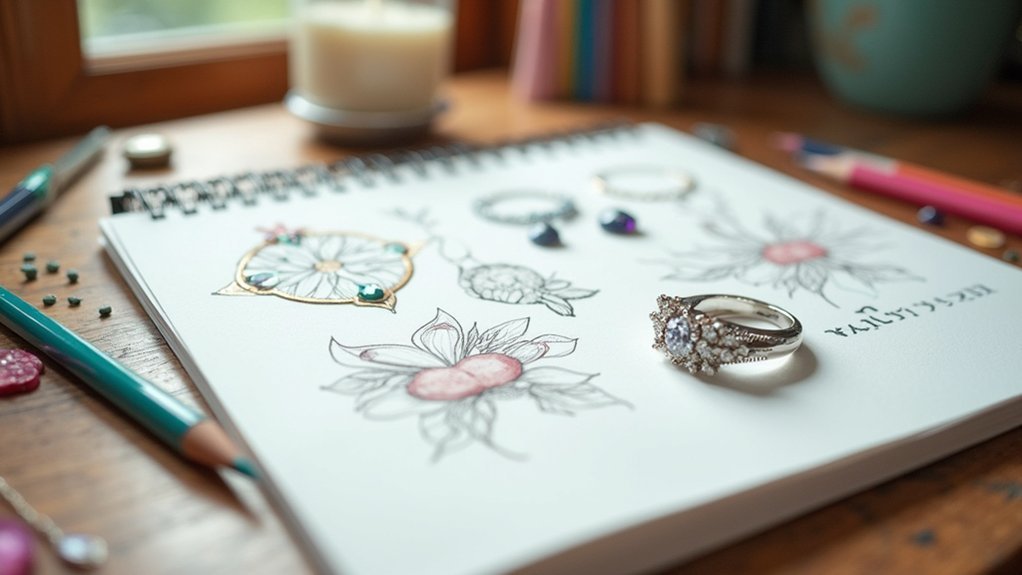
When you sit down with a client for a jewelry consultation, your ability to truly hear and understand their vision becomes the foundation for creating a piece they’ll treasure. Active listening means concentrating fully on their words, understanding their emotions, and responding thoughtfully to their needs.
Ask open-ended questions that encourage clients to share their style preferences, inspirations, and specific elements they envision. Use visual aids like photos or sketches they bring to grasp their ideas accurately.
Throughout the consultation, summarize and reflect their thoughts back to guarantee you’re capturing their vision correctly. This approach builds trust and rapport, making clients comfortable sharing intimate details about their desired bespoke piece while establishing the collaborative foundation essential for successful custom jewelry creation.
Gathering Visual References and Design Inspiration
Visual references serve as your design compass, transforming abstract ideas into tangible inspiration that bridges the gap between imagination and reality.
Visual references transform abstract dreams into concrete design direction, serving as the essential bridge between your imagination and your jeweler’s craft.
You’ll want to collect images from Pinterest, Instagram, and jewelry magazines to effectively communicate your aesthetic preferences during consultations. Use targeted hashtags like “#customjewelry” and “#engagementringdesign” to streamline your search for specific styles that resonate with your vision.
Bring various inspiration images including sketches, cut-outs, and photographs to enhance communication clarity with your jeweler. Creating a mood board establishes a cohesive theme for your custom jewelry design process, making consultations more focused.
While sharing your visual inspirations, remain open to designer suggestions—this collaboration often leads to innovative ideas that can elevate your final design beyond initial expectations.
Establishing Budget Parameters and Material Options
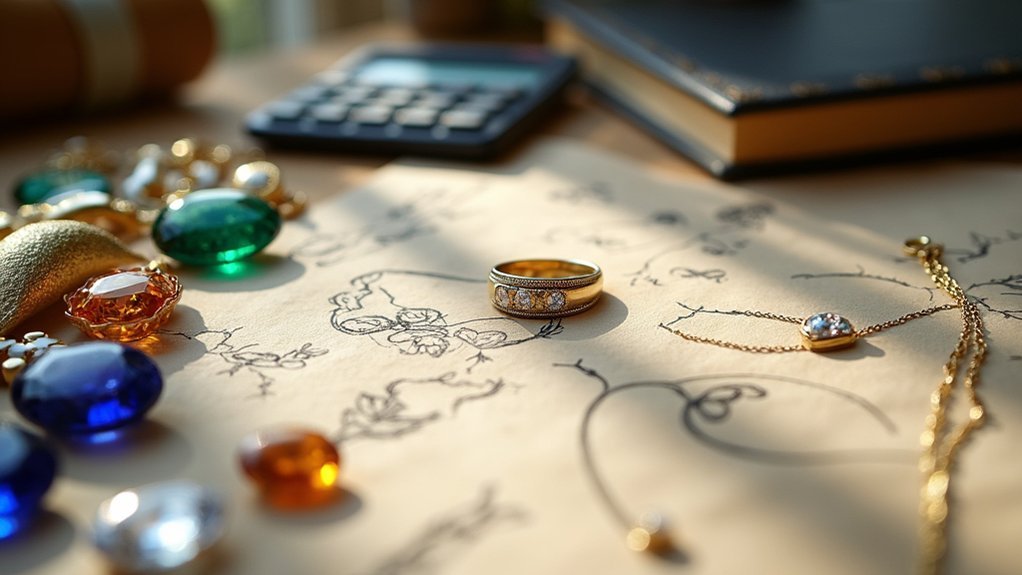
You’ll need to establish a realistic budget before sketching begins, as bespoke pieces typically start at £2,500 for engagement rings and £3,000 for custom jewelry.
Your budget directly influences material choices, from 10k to 18k gold varieties and gemstone selections that’ll work within your financial parameters.
Consider how different metals like yellow, rose, and white gold affect both cost and durability when you’re planning your initial design concepts.
Budget Range Planning
Before diving into design sketches, establishing a clear budget range forms the foundation of any successful custom jewelry project.
You’ll need to communicate that bespoke engagement rings typically start around £2,500, with costs increasing based on materials and complexity. When you discuss budget openly with clients, you’re providing exceptional customer service by setting realistic expectations from the start.
Custom jewelry costs more than off-the-shelf pieces, but clients receive unmatched quality and uniqueness.
Higher budgets allow for premium materials, intricate designs, and larger stones, while lower budgets require creative alternatives like different metals or smaller gems.
Clear budget communication prevents misunderstandings and guarantees you can tailor material suggestions that align perfectly with your client’s financial constraints throughout the design process.
Material Cost Considerations
Three primary material categories drive the majority of your jewelry costs: metal selection, gemstone choices, and design complexity features.
When you’re sketching your piece of jewellery, you’ll need to understand how each element affects your budget. Gold purity levels—10k, 14k, or 18k—directly impact both cost and durability, while the choice between yellow, white, or rose gold adds another pricing variable.
Your metal and stones selections work together to establish the foundation of your budget, especially for engagement rings where diamonds command premium pricing based on the four C’s.
- Metal selection accounts for 30-40% of total costs in most custom pieces.
- Gemstone quality can represent 50-70% of engagement ring budgets.
- Design complexity adds 15-25% for intricate detailing and custom engravings.
Communicate these considerations early with your jeweler.
Translating Ideas Into Initial Design Sketches
When clients walk into your studio with dreams of their perfect piece, transforming their abstract vision into tangible sketches becomes your first creative challenge. Start by encouraging them to share inspirations—photos, magazine clippings, or rough sketches they’ve created. This foundation helps jewelry designers understand their aesthetic preferences clearly.
Use specific terminology during your jewellery consultation. Reference “solitaire,” “halo,” or “bezel settings” to guarantee you’re both speaking the same language. Document everything meticulously: preferred metals, stone specifications, desired engravings, and special details.
Clear communication through professional terminology ensures both designer and client share identical expectations throughout the custom jewelry creation process.
Create initial sketches incorporating these discussed elements, emphasizing key features like stone cuts and setting styles. Present your drawings for feedback, fostering open dialogue about adjustments.
This collaborative approach in custom jewelry design guarantees your sketches accurately reflect their vision while building trust throughout the creative process.
Communicating Technical Constraints and Possibilities
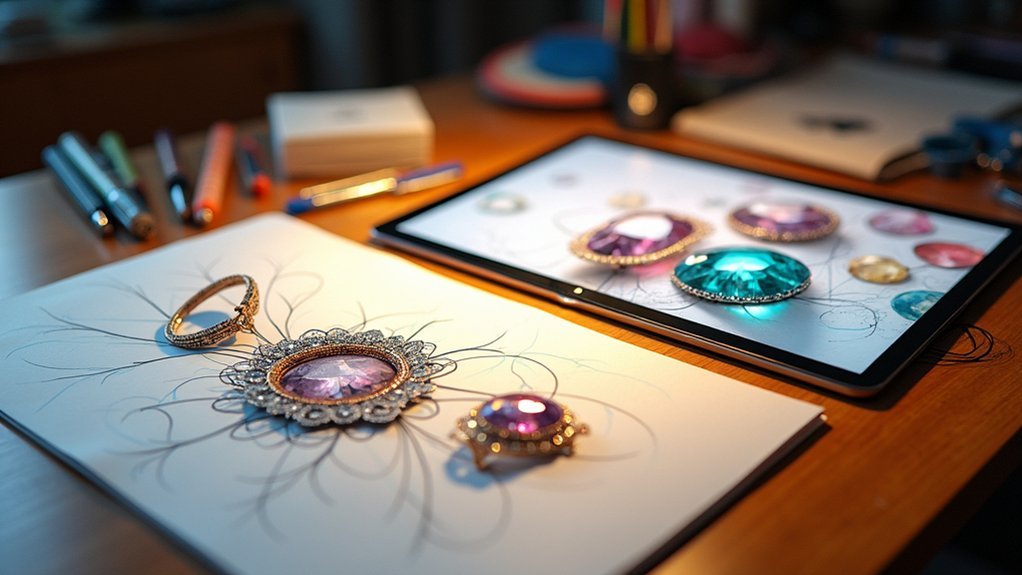
After establishing a clear vision through collaborative sketching, you’ll need to guide clients through the technical realities that shape their dream piece. Your role involves translating creative aspirations into achievable bespoke jewellery while managing expectations about material limitations and structural requirements.
Each type of metal brings specific characteristics—gold’s malleability, platinum’s durability, or silver’s affordability—that directly impact the final piece. You must communicate how gemstone hardness affects longevity, especially for daily-wear items like rings.
Setting styles also dictate stone compatibility and structural support needs.
Visual aids become essential here:
- Sketches showing alternative materials that maintain the design’s essence while improving functionality
- Reference images demonstrating how different metals age and patina over time
- Technical drawings illustrating how setting choices affect stone security and piece durability
Refining Concepts Through Collaborative Feedback
Once you’ve established technical parameters, the iterative refinement process becomes your most powerful tool for achieving design excellence.
Transform your custom jewelry consultation into a dynamic collaboration by actively listening to client ideas and preferences throughout each sketch revision. Use mood boards and inspirational images to bridge communication gaps, ensuring you’re both visualizing the same concept.
Provide sketches that reflect their feedback immediately, creating multiple iterations that showcase different approaches. Encourage open dialogue about materials, shapes, and styles—this jewelry design process thrives on honest input.
Document every decision and preference shared during consultations to maintain alignment with their vision. This collaborative approach transforms initial concepts into refined designs that truly capture what your client envisions for their unique piece.
Presenting Final Sketches for Client Approval
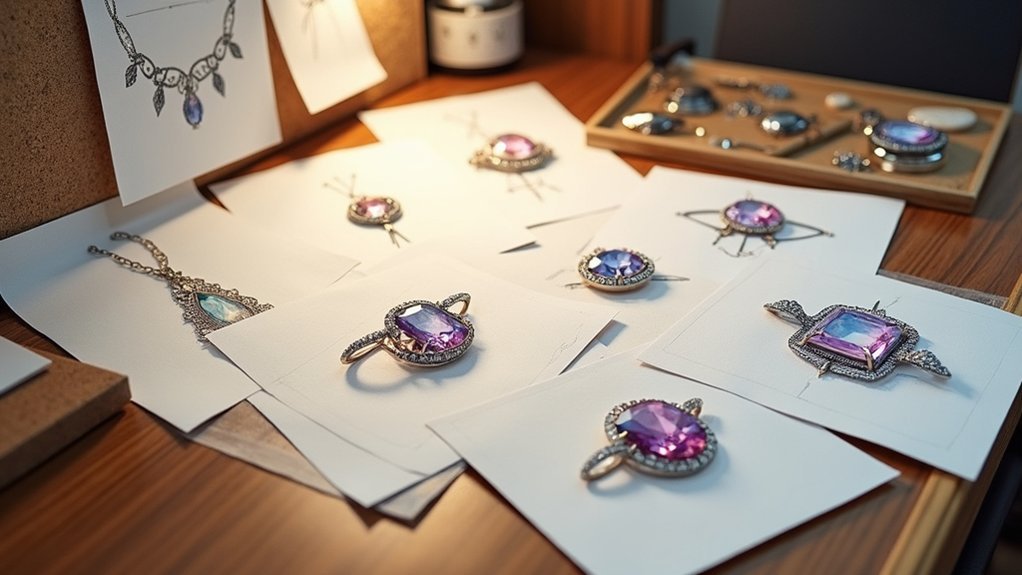
When you’re ready to present final sketches, you’ll need to establish clear visual standards that showcase materials, colors, and textures with precision.
You should implement a structured revision process that encourages client questions while maintaining project momentum.
Most importantly, you must document every approval decision and requested change to guarantee your final piece perfectly matches the client’s expectations.
Visual Clarity Standards
Since your final sketches serve as the bridge between creative vision and client approval, establishing clear visual standards becomes crucial for successful project outcomes.
Your sketch presentation must deliver exceptional visual clarity that allows clients to understand every design element without confusion. Effective visual standards guarantee your drawings communicate precise details while facilitating meaningful client feedback throughout the approval process.
- High-Resolution Detail Standards – Present sketches in crisp, clear images that showcase intricate design elements, textures, and fine details that clients need to evaluate accurately.
- Color-Coded Material Indicators – Use distinct colors and annotations to identify different materials, finishes, and gemstones, helping clients visualize the final piece’s appearance.
- Multi-Angle Thorough Views – Provide front, side, and perspective drawings that reveal the piece’s dimensionality and highlight unique design features effectively.
Revision Process Guidelines
With your visually clear sketches ready, you’ll need a structured approach for presenting them to clients and managing their feedback effectively. Present final sketches in an organized format that highlights key design elements and demonstrates your creative choices throughout the consultation process.
Use digital rendering tools or high-quality hand-drawn illustrations to help clients visualize their finished piece accurately. Encourage detailed feedback and create space for open discussion about necessary adjustments.
Establish a clear timeline for your revision process, specifying how many revision rounds you’ll include to manage expectations and maintain project momentum. Document all client feedback and decisions thoroughly—this creates a valuable record that guides final execution and guarantees their jewellery journey proceeds smoothly from concept to completion.
Approval Documentation Methods
How do you transform your polished sketches into a professional presentation that secures confident client approval? Effective approval documentation methods require high-quality digital renderings or physical drawings that communicate every detail clearly.
Include thorough annotations highlighting metal types, gemstone selections, and precise dimensions to eliminate confusion during client consultation.
Your approval process should incorporate these essential elements:
- Structured approval forms that outline each design aspect, requiring client signatures to formalize acceptance before production begins.
- Interactive feedback sessions where clients can comment directly on sketches, ensuring collaborative refinement of their vision.
- Follow-up meetings that allow detailed discussions and last-minute adjustments, maintaining client involvement throughout the approval phase.
This systematic approach transforms sketches into binding agreements while ensuring client satisfaction.
Frequently Asked Questions
How Long Does the Entire Jewelry Design Consultation Process Typically Take?
You’ll typically spend 1-3 hours in your initial consultation, depending on project complexity. Follow-up meetings last 30-60 minutes each. The entire process from concept to final approval usually takes 2-4 weeks with multiple touchpoints.
What Happens if I Want Major Changes After Final Sketch Approval?
If you request major changes after final sketch approval, you’ll typically start a new design phase. This means additional fees, extended timelines, and potentially reworking contracts since approved sketches usually begin production.
Do You Offer Virtual Consultations for Clients in Different Locations?
You’ll find most jewelry designers offer virtual consultations through video calls, screen sharing, and digital sketch reviews. You can discuss designs, view sketches, and approve concepts remotely, making location irrelevant for collaboration.
Can I Bring My Own Gemstones or Materials to Incorporate?
You can absolutely bring your own gemstones or materials to incorporate into your custom jewelry design. We’ll assess their quality, authenticity, and suitability for your desired piece during consultation.
What Intellectual Property Rights Do I Have Over My Custom Design?
You’ll typically retain rights to your original design concept, but ownership depends on your contract with the jeweler. You should clarify intellectual property terms upfront before starting work together.
In Summary
You’ll transform client dreams into stunning jewelry designs by mastering these consultation techniques. Don’t underestimate the power of active listening and visual communication—they’re your foundation for success. Remember to establish budgets early, embrace collaborative feedback, and present your sketches with confidence. When you follow this structured approach, you’ll build stronger client relationships and create pieces that truly capture their vision. Your sketching skills combined with effective consultation will set you apart.

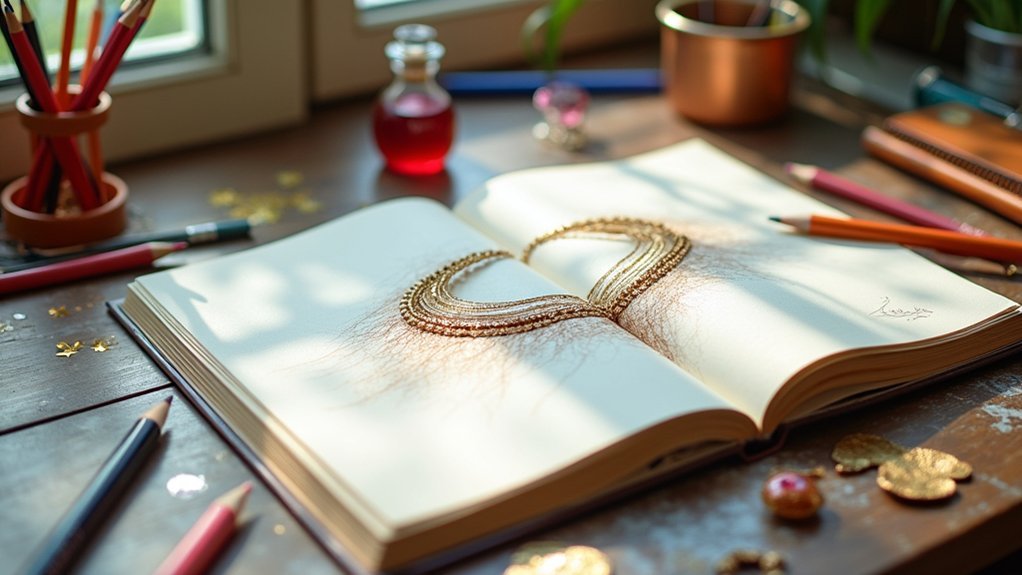
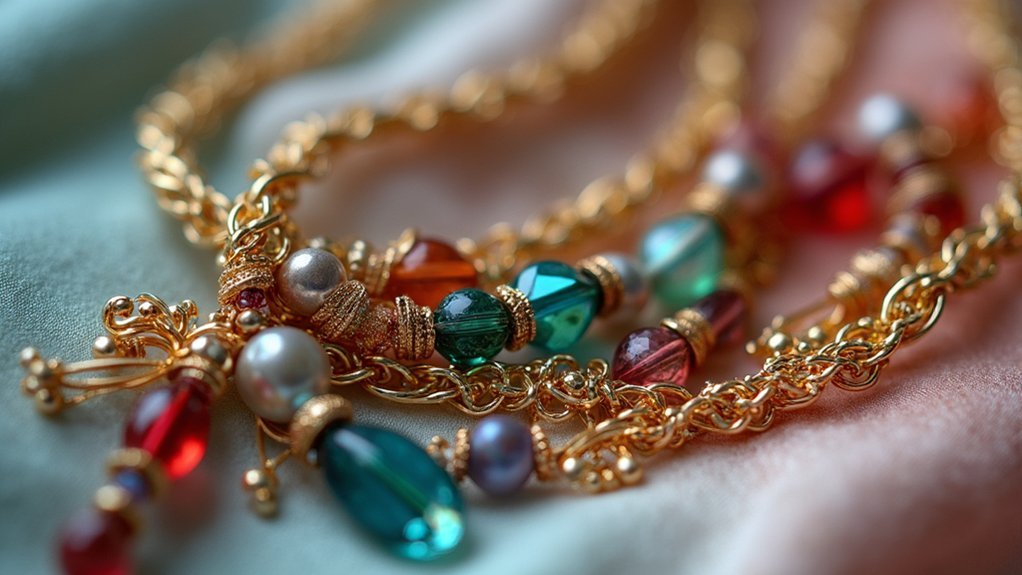
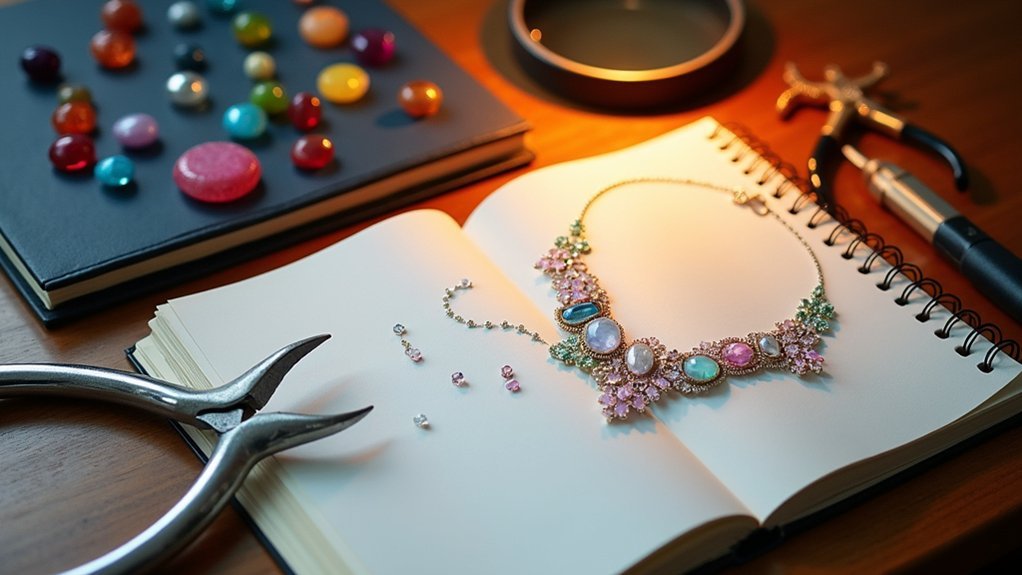
Leave a Reply